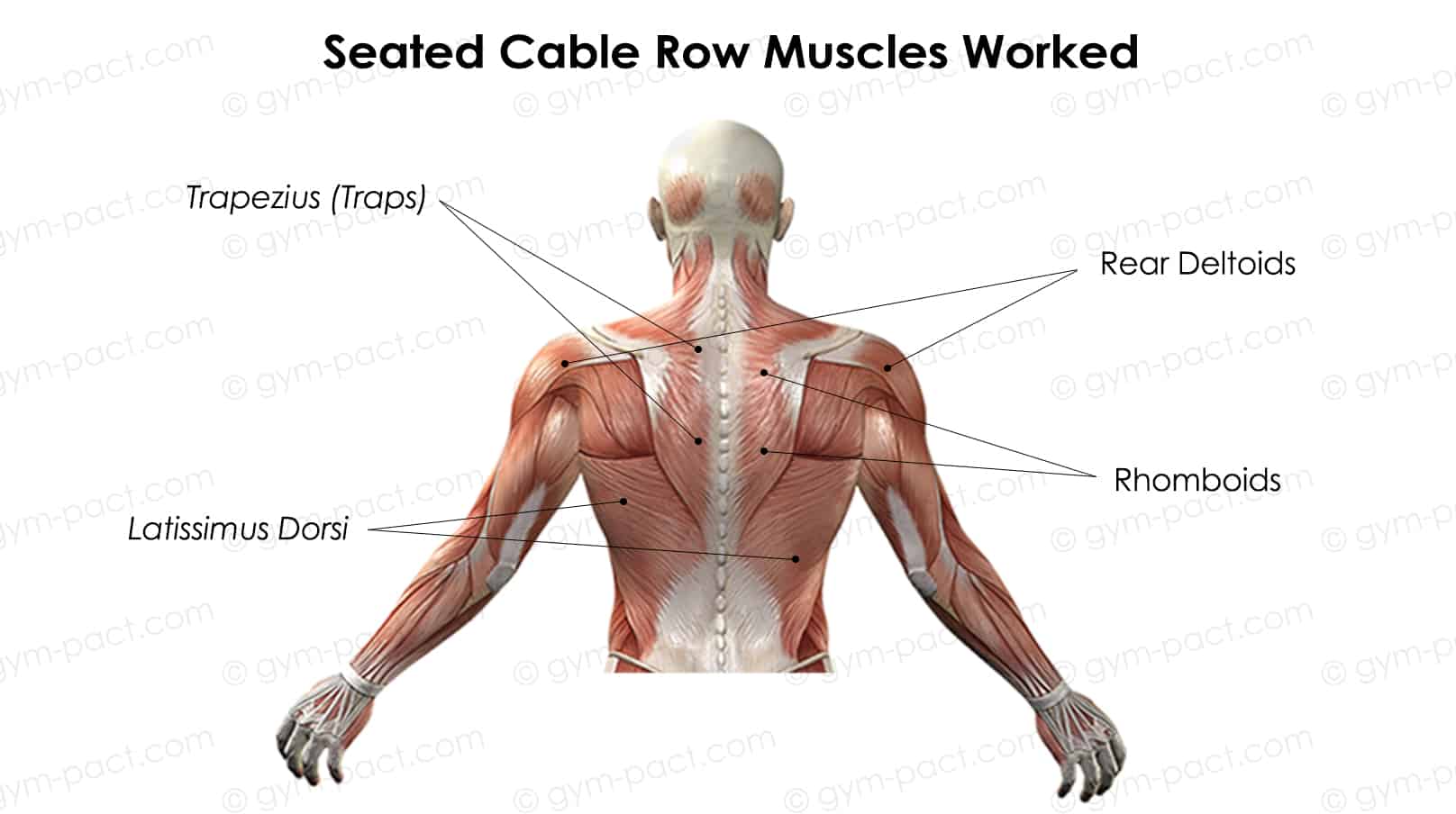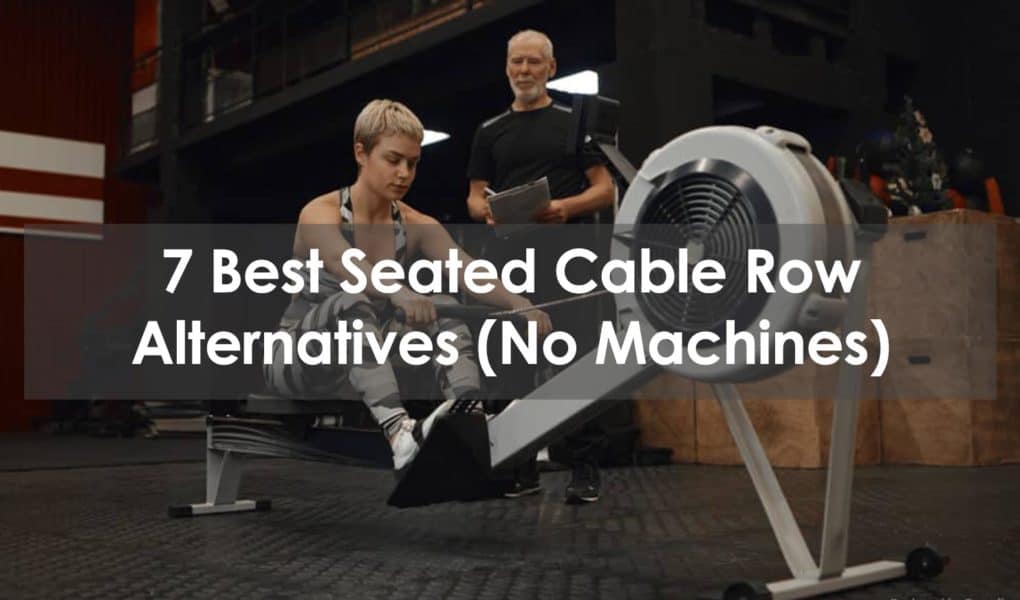Building a strong back keeps you healthy, helps you look your best, and is key for any kind of performance.
However, you won’t always have the tools you want. Sometimes, great training is about working around your limitations.
For example, what if you don’t have a seated cable row?
Today, I’m taking you through my favorite seated cable row alternative exercises. We’ll be looking at bodyweight, free weight, and some alternative machine exercises for a stronger, healthier back.
Work the same muscles
The point of seated cable row alternative exercises is to target the same muscles. That’s how you ensure you’re developing those key muscle groups without a cable row machine.
So what muscles does the seated cable row use? There are 3 key areas to look at:

- The lats: these are huge muscles involved in other exercises, like the pull-up. They form the v-taper, which helps build a great physique and control depression of the shoulder blades.
- The scapular retractors: these include the traps, rear delts, and rhomboids, which are key for good posture, like the lats, and balance out the demand of the pecs. They also keep the shoulders healthy.
- The biceps and grip: cable rows train the arms in the pulling motion, as well as the forearms. These are great for keeping the elbow healthy and building bigger, stronger arms.
These muscles keep the shoulders healthy and support proper, healthy posture in the upper back and neck.
Most people are lacking in the back of the shoulder girdle but will work on the front with upper body pressing. Whether it’s push-ups or bench press, rowing and alternative exercises balance out this front-dominance!
7 Best Cable Row Alternative Exercises
1) Dumbbell Rows
I love single-arm dumbbell row exercises – everyone should be practicing them. It offers great strength, stability, and mass development.
The single-arm dumbbell movement recruits the stabilizer muscle groups around the shoulder and ensures you’re building the whole back. It’s a lighter movement and suits higher rep sets for muscle mass and motor skill practice.
- Take a dumbbell in one hand and support your upper body with the other. You can use a bench or other flat surface for this.
- Set up so that your hips are square and your back is flat, with the dumbbell at arm’s length.
- Perform the exercise by pulling the shoulder back and bending the arm, pulling the elbow past the line of your body.
- Squeeze at the top position, pausing briefly, and think about pulling the elbow back and across your body.
- Slowly lower the weight, under control, to complete the rep in the starting position.
2) Barbell Bent-over Row
The barbell row uses heavier weights but reduces the use of shoulder stabilizers. It’s always good to use a single-arm seated cable row alternative for this exact purpose.
This makes it a great mass building alternative, as well as being a more specific alternative to seated cable rows. It’s almost exactly the same movement if you’re precise with your form – and it offers great variations. Since bar rows use plates, you can adjust the amount of weight easily.
- Deadlift a barbell to the standing position with a mid-grip. This is roughly one thumb’s length into the knurling.
- Hinge at the hips, bend your knees, keeping the back tight, and set the bar under the armpits.
- Pause in this bent-over position, stabilizing yourself with the abs and hips.
- Row the barbell towards the bottom of your sternum, focusing on bringing the elbows to – and then behind – your body.
- Squeeze at the end of the movement, pausing briefly, before lowering back to the start position. This ends the rep.
Pendlay row: this row variation mimics the same angles seen in cable rows or the t-bar row. You have to support the position with your lower body, however, which makes it more functional but also more demanding on your recovery.
Yates row: this is like a normal barbell bent-over row but with a supinated (reverse) grip to focus on bicep and teres activation. A great alternative to mix in for complete back development. Again, you can perform this with a t-bar.
3) Lat pulldown
This uses a lat pulldown machine, not a cable row machine.
However, it targets some of the key muscles of the row in a different direction. The traps, lats, and rhomboids are still doing the work, but in a vertical pull.
This is great for building 3-dimensional scap control. It also ensures you’re building the width in the back that comes from focusing on the lats. This is a great combo with any other seated cable row alternative on this list!
- Set up on the lat pulldown machine with an upright torso and a wide grip on the bar.
- Keeping the core tight, avoid leaning back as you pull the bar down. Focus on bringing the elbows down and back, into your chest.
- Hold the bottom position briefly, squeezing the scap down and back.
- Return to the original position by pushing the elbows forwards and up, slowly.
- When you reach the starting position, the exercise is complete. Keep tension on the bar from the lats between reps, if possible.
4) Standing cable row
If you have any cable machine, you can start building with a standing cable row alternative.
There’s no reason you need to be seated to get a great back workout!
This is the same as a seated cable row, using the same mid-grip attachment, but from a standing position. You need a slight forward lean from the hips, but it’s still a great exercise if you can’t take the seated position.
- Taking a mid-grip on the cable handle attachment, walk back until there is tension at arm’s length.
- Bend your knees slightly and lean forward. Do not arch your back, and keep weight in the middle of the foot.
- Pull the attachment into your lower chest until it comes into contact with your chest.
- Hold this position briefly, making sure to tuck the elbows back and towards each other. Try and feel the muscle squeeze here.
- Slowly return to arm’s length, controlling the weight throughout the movement, to end the repetition.
5) Chest supported row
If you have access to a sturdy surface like a flat bench, the chest-supported row might be the best seated cable row alternative. It’s certainly the best choice for free weights.
There are a few options for this seated cable row alternative. You can use a flat bench, a chest-supported row machine, or just a t-bar row machine/station.
Chest-supported dumbbell row (seal row):
- Set up on the bench, station, or machine with your sternum well-supported. Take a medium grip on the barbell, dumbbells, or t-bar row station.
- Set your core tight at the start and make sure you’re pushing your chest into the pad at all times. This keeps you strict on the movement!
- Row the weight towards your chest by pulling the shoulder blades together and bending the arms. Get your elbows in-line with your body.
- In this top position, squeeze the scap region and pause briefly.
- Lower the weights back to arm’s length to complete the exercise. You can also keep tension in between reps, but that will shift the focus to the biceps.
T-Bar Row:
Each exercise cuts out any cheating or compensatory movement. These isolate the back muscles, while also helping reinforce good movement patterns.
I love this exercise and its dumbbell equivalent – the seal row. They offer a great, targeted back exercise that forces you to practice deliberately!
6) Landmine row
This is a simple movement you can use if you’ve got a barbell. You can use a landmine bar attachment or simply stack it into a corner to get the same results.
This is a return to the single-arm rowing we saw with the dumbbell. This barbell variation is easier to load, however, especially if you only have a barbell on-hand. This simulates the single-arm dumbbell row without the need for multiple dumbbells to progress.
You can stand parallel to the barbell, or at 90-degrees, depending on what is more comfortable. You can also perform a landmine t-bar row by standing over the barbell.
- Set up a barbell in a corner or with the landmine attachment. Stand at the end of the bar, so that you can hold it on one side in a slightly bent-over position.
- Taking the end of the barbell at arm’s length, stabilize yourself with the hips and core. Don’t let your trunk move during the exercise.
- Row the weight towards yourself, pulling the elbow in line with your trunk or slightly behind.
- Make sure you keep the hips square at the top of the movement and don’t rotate to finish the rep.
- Hold the top position briefly before slowly lowering back down to arm’s length and finishing the exercise.
7) One-Arm Cable row
This is a perfect exercise for getting the benefits of the seated row without the equipment. It also introduces more shoulder stability training, helping reduce shoulder injury risks and strengthen your stabilizer muscles.
The constant tension provided by the pulley system is great for keeping the weight on your lats and traps through the whole range. It can also be performed from standing, which makes it more accessible and versatile than the seated version.
- Take a single handle in one hand, standing straight-on with the cable machine or sitting on a bench/box. Put a slight bend in your knees and hips, keeping your core active.
- Begin with the handle at arms’ length, feeling a mild stretch in the lat and trap.
- Row the handle towards your chest, pulling the elbow back behind your torso, and squeezing the shoulder blade back and down.
- Slowly return to arms’ length, moving back to the original ‘stretched’ position and letting the shoulder blade come forwards.
- When you reach arms’ length, the rep is complete – keep the upper back muscles active in this position for better results.
This is a great exercise for feeling the mind-muscle connection and building better movement quality. These are key for improving all your exercises and even correcting shoulder and upper spine posture!
Conclusion
Seated cable row machines are great, but you don’t need one. You can score a brilliant back workout with bodyweight or free weights if you use these cable row alternatives.
You can get all the same benefits: train the right muscles, use the same movement, and even reduce back stress. These all add up to a fantastic set of seated cable row alternatives.
In all of these exercises, what matters most is practicing good technique. Moving your arm and scap deliberately will make or break any of these exercises. Make sure you’re putting control and movement quality first!
Frequently Asked Questions
How do you do seated cable rows without a machine?
You’re probably not going to be performing seated rows if you don’t have a cable row machine. You could improvise with a resistance band but it won’t simulate the right weight.
The goal is to find a good cable row substitute that builds the same muscles and movements.
Other rowing movements are a good choice – whether that’s a bodyweight row or free weights. You can row with almost any of the equipment you’d find in a standard gym: a cable machine, t-bar, or just a dumbbell row.
What muscles do rows work?
Rowing movements are all about the arms and the scap. The depression and retraction of the shoulder blades train the lats, improves lower trap engagement, and strengthens the rhomboids. These are crucial for posture and shoulder health.
That’s why the cable row alternatives we’ve outlined focus on these muscles. They build a wide, strong back and healthy shoulders. These counter-act postural problems, as well as balancing your development out with pushing or pressing exercises.







